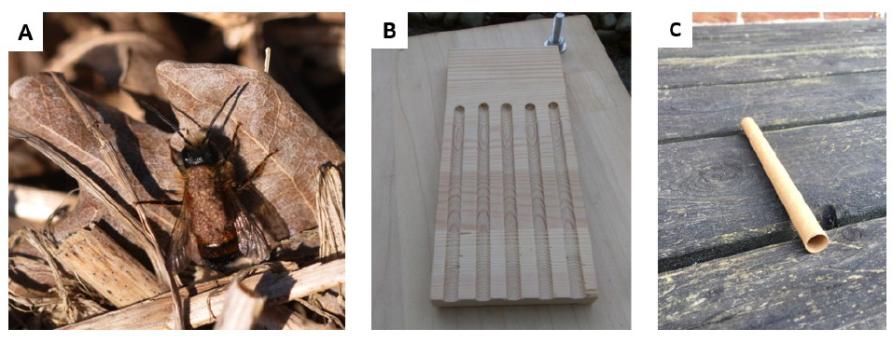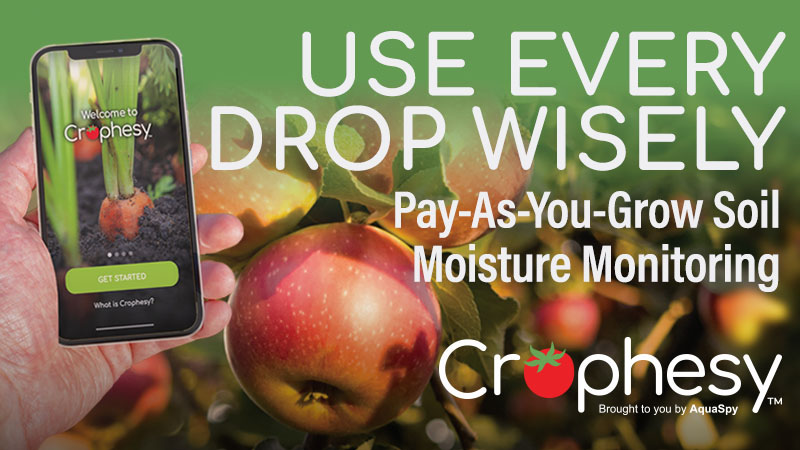Pome Fruit Pollination Strategy: Protect the Mason Bee
Mason bees (Osmia spp.) are receiving increasing attention because they are highly effective pollinators of several fruit crops. However, several parasites are known to be harmful to the development of mason bee offspring. To date, clear, effective guidelines to control or prevent infestation by these parasites in the bees’ nests are lacking. This study investigates how different types of nesting materials affect the development of the European orchard bee (O. cornuta) and the infestation of parasites in their nests.
There are several parasites associated with the nests of solitary bees. For example, there are kleptoparasites that feed mainly on the larvae’s food (mites, drosophilid flies, etc.) and brood parasites that feed mainly on the larva itself (parasitic wasps, parasitic flies, etc.). One of the most common parasites, both in the Pacific Northwest as well as in Europe, are parasitic mites that feed on the pollen of the larvae (Chaetodactylus spp.).
Different types of nesting materials are used for rearing mason bees, such as bamboo, reeds, cardboard tubes, nest modules consisting of wooden grooved boards, and wooden blocks with drilled holes, etc. Nest modules made of wooden grooved boards are suggested as a possible solution against certain parasites such as mites because these nests can be cleaned every year to remove the mites and other parasites. However, the influence of the type of nesting material on the infestation of various parasites has not yet been investigated for mason bees.

A European orchard bee (Osmia cornuta) covered with parasitic mites (A). Detail of the wooden grooved boards (B), and detail of the cardboard tubes (C), both of which were used in this study to rear the mason bees.
Images courtesy of Maxime Eeraerts
THE RESEARCH
Guidelines or rearing methods that can reduce the infestation of these parasites are necessary for the efficient use of mason bees for fruit production. For this purpose, two types of mason bee nesting materials were subjected to an experiment, namely cardboard tubes and nesting modules composed of wooden grooved boards.
One nest was a module composed of wooden grooved boards (200 round nest cavities, 8 mm diameter, 13 cm deep). The other nest box had cardboard tubes as nest cavities (200 nest cavities, 8 mm diameter, 12 cm deep). Three thousand five hundred cocoons of the European orchard bee were released next to the two nest boxes in late March 2019 in Londerzeel, Belgium. In January 2020, all sealed nest cavities of both nests were opened and the contents of each cavity were inspected. For each cavity, the total number of brood cells built, the total number of well-developed bee cocoons, the number of brood cells with pollen left unaffected, and the number of brood cells infested with parasitic mites were noted.
THE FINDINGS
This initial, preliminary study indicates that cardboard nest tubes reduce parasitic mite infestation by 81.8% compared to wooden nest modules. Thus, successful development of the horned mason bee is promoted by 15.5%. This can be explained by the way these mites disperse in nest boxes. It is more difficult for mason bees in the wooden nest corridors to completely seal the brood cells with a dense wall. This allows the mites to move more easily from one brood cell to another through small cracks and crevices in the wooden nest boxes.
Also, the frequent expansion and shrinking of the wood in the nesting boxes of wooden grooved boards creates openings that can be used by the mites or go from one cell/cavity to another. Since cardboard tubes are completely round and sealed, it is easier for the bees to completely seal the brood cells, which will prevent the spread of mites.
This reasoning is supported by the fact the cardboard tubes contained more brood cells with pollen that had not been infested by mites. Therefore, the use of cardboard nest tubes (or similar materials such as bamboo) is recommended as an effective management strategy to manage mite infestation when rearing mason bees for fruit pollination.
FURTHER RESEARCH
With an ongoing research project in collaboration with the Department of Zoology of the Belgian Research Centre for Fruit Cultivation (PCFruit vzw), we are going deeper into some additional, pertinent questions. More specifically, we are studying whether this pattern of reduction of other parasites also occurs in function of the type of nesting material.
In addition, we will determine how the infestation of different parasites varies as a function of time and as a function of the surrounding landscape. This will help to better understand the necessary actions to apply mason bees for pollination of fruit crops. To be continued.









